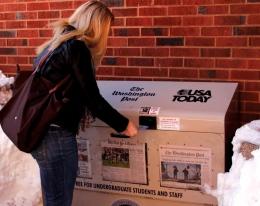Free copies of The New York Times, The Washington Post and USA Today are once again available through The Collegiate Readership Program, which restarted Monday despite school closures after discontinuing last year due to a lack of funds.
Ninety copies of each paper will be available every weekday, 70 of which will be in newsstands outside the Intercultural Center and 20 of which will be located outside the Rafik B. Hariri Building. This amount is half the original 180 daily copies of each paper that were made available to all members of the university community with a valid GOCard last year.
The decrease in quantity of papers resulted in a decrease in price, enabling the program to continue despite sponsors’ budget cuts since the 2008-2009 school year. The program’s cost per semester last year totaled $12,500. Sponsors will only be paying $6,000 to fund the program this semester.
“It’s exactly half the papers, and less than half the cost,” explained Will Cousino (SFS ’12), vice president of Student Advocacy for InterHall and leader of the movement to reinstate the program.
“Hopefully in the end, my efforts have resulted in a more sustainable program that suits Georgetown and will continue to be supported in semesters to come,” Cousino said.
InterHall, Georgetown University Student Association, The Corp, Georgetown University Alumni and Student Federal Credit Union, the Senior Vice President’s Office and the McDonough School of Business have funded the program’s return. GUSA granted the largest donation, which amounted to $2,000.
GUSA Vice President Jason Kluger (MSB ’11) said he is happy to have to program back.
“I’m ecstatic. We’ve been fighting since the summer to have it back, so to see the actual newspapers was extremely exciting,” Kluger said.
“Other senators and I felt this was a worthwhile program because people expressed support for reading a physical copy of the newspaper,” Sen. Chetan Panda (SFS ’13) said.
“I think that having hard copies of newspapers readily available will definitely increase students’ interest in the world around them, both on the communal level and internationally,” agreed Nikki DesForges (COL ’13). “It’s the easiest way to escape the Georgetown bubble.”
Despite the enthusiasm for the availability of print newspapers on campus, some debate whether the expense is necessary if news can be found online as well.
“There are better ways that this money could be allocated besides free printed newspapers,” Jenna Finch (NHS ’13) said. “We all have access to computers, and most students already regularly use the Internet to read the news.”
“There was some question as to whether it would be more cost-effective to simply allow people to go to newspapers’ Web sites to access the news,” Panda added. “In light of The New York Times’ decision to make their Web site a subscription service [starting in 2011], this decision [to provide free newspapers] affords students a viable alternative.”
The Collegiate Readership Program, owned by USA Today and adopted by nearly 500 schools around the country, aims to make students more globally conscious.
According to the program’s Web site, “The goal of The Collegiate Readership Program is to enhance the learning environment on campus, by exposing students to the news in their living, learning and community spaces. The program is designed to promote civic literacy and global awareness on campus through students’ daily exposure to the news.”
The program began in 1997 at Pennsylvania State University, and started as a pilot program at Georgetown in spring 2008.”








